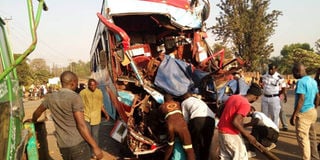Road safety measures ought to be aligned to crash data

The World Health Organisation estimates that Uganda loses 29 people per 100,000 to road crashes annually, a figure that is much higher than the global average of 18 people per 100,000. Photo/ file
What you need to know:
- These figures dire as they are, have become the norm. The country continues to grapple with the menace of road crashes with little to no tangible success yet. Statistics have hovered around 11 deaths per day for a while now.
Uganda traffic police released yet another gloomy weekly report (23-30 July) on the state of road carnage; 451 crashes, 219 serious injury crashes and 79 dead.
These figures dire as they are, have become the norm. The country continues to grapple with the menace of road crashes with little to no tangible success yet. Statistics have hovered around 11 deaths per day for a while now.
This has not been due to a nonchalant attitude towards the crashes scourge. Far from it, the authorities are on their toes. From the amendment of the traffic and road safety act, to the deployment of the traffic police and enforcement of reflector apparel for the boda boda riders, you cannot fault anyone for a lack of effort.
But to ensure a more effective response that will yield tangible and measurable results there is need to align the measures to the existing data on crashes. For example, the Kampala Road Safety Annual Report 2022, by KCCA in collaboration with the Uganda police and Bloomberg Philanthropies Initiative for Global Road Safety (BIGRS) is one resourceful place to start.
The report not only presents statistics on deaths and injuries from road traffic crashes that occurred in Kampala in 2021, it also analyses the high-risk fatal and serious injury crash locations in the City and the corresponding road-user risk behaviors such as helmet use, speeding, and seat-belt/child-restraint use. Among the in-depth details, the report indicates crashes and deaths by time of day.
In part, the report states that; “In 2021, a higher number of crashes occurred between 6pm and 8pm; that’s 734. However, fatal crashes were highest between 4pm and 6pm; that’s 681.”
The findings also show crashes by day of the week. 35 percent of deaths in 2021 occurred following crashes on Saturdays and Sundays; that’s 70 and 75 respectively. Using crash coordinates from 2019 to 2021, the report also shows the location of all crashes; both serious and fatal crashes, pedestrian as well as motorcycle crashes.
70 percent of the high-risk locations and corridors were on arterial roads. Given such detailed findings indicating the day, time and location of crashes, the authorities can devise specific mitigation measures tailored to the existing data.
More than the gloomy figures of the dead and injured, a crucial addition to the regular road traffic media updates, should be what the authorities are doing about this scourge in line with the available data.
It is only then that we shall be able to evaluate the impact of the various interventions. For example, the report reveals the top-10 high-risk fatal crash spots, 2019-21. The Kalerwe roundabout (Northern Bypass), Nakulabye intersection (Balintuma and Hoima Road), Kisaasi-Kyanja road junction, roundabout near Nkumba University, Kampala campus and the Bwaise roundabout (Northern Bypass) round off the top fi ve deadliest spots in Kampala.
Similarly, the report also reveals the top-10 high risk fatal crash corridors, 2019-21. Entebbe road, Kisaasi-Nalya round about (Northern Bypass), Busega-Namugongo roundabout (Northern Bypass), Gayaza roundabout (Kalerwe) – Kyebando police post (Northern Bypass) and Ggaba road occupy the top five slots.
They each accounted for 36, 31, 30, 27 and 26 deaths respectively during this time period. The road safety updates would be enriched with such level of detail revealing what is being done about the most dangerous spots and corridors on our roads, and the corresponding results.
Not lost on me are some of the hiccups to implementing the most desired interventions, lack of enough funds being the most obvious one.
Yet the smaller the resource kitty, the shrewder we ought to be when utilizing it so that it is addressed to specific issues to achieve impactful results.
The authorities need to align the road safety measures to the existing crash data, not only in Kampala but the country at large. Otherwise, the adage, that the greatest distance, far greater than the Grand Canyon, is the one between what we know and what we do, will ring true.
Eden Kironde, [email protected]





